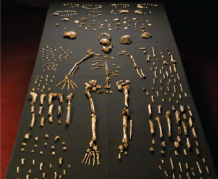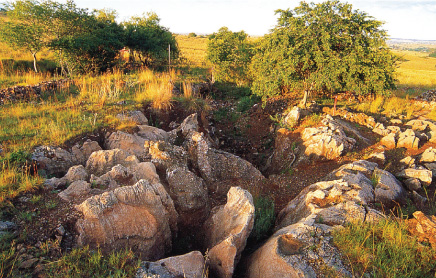2
THE GREAT BREAKTHROUGH
The transition from pre-human to human history took place in Africa. A series of fossil discoveries provides clear evidence that Homo sapiens emerged in Africa about 200 000 years ago, whilst recent analysis of a skull found in South Africa helps to confirm current thinking that modern humans spread out of Africa to occupy the rest of the world relatively recently – about 50 to 60 000 years ago. Further evidence shows how human beings gradually acquired the skills that have helped them become the dominant species on earth. Of these, the most important have been the capacity to communicate through complex language and to think symbolically.
THE DISCOVERY, IN 1925, OF A REMARKABLY COMplete fossil skull from Taung, west of Kimberley in the Northern Cape, radically changed our understanding of human origins. This skull of a child, described as Australopithecus africanus (‘southern ape from Africa’), was considered to be the ‘missing link’ between apes and humans. Subsequent discoveries of other hominids in the Sterkfontein area near Johannesburg – now known as the Cradle of Humankind – led to the recognition that humanity may well have had its origins in southern Africa. Discoveries being made on an ongoing basis at various sites in South Africa corroborate this theory.
A particularly exciting discovery was made in 1947 at Sterkfontein when the skull of an adult Australopithecus africanus was found. She is known as ‘Mrs Ples’. Thirty years later, a 3.2-million-year-old skeleton of a female Australopithecus afarensis was found in Ethiopia. She is known as ‘Lucy’, after the Beatles’ song which was playing in the palaeoanthropologists’ camp the night after the discovery. In the 1990s a more complete fossilised skeleton, known as ‘Little Foot’, was discovered at Sterkfontein. It had a slightly divergent big toe, indicating a place in evolution somewhere between apes and humans. In 2010 another, no less remarkable, discovery was announced in the same area. Two skeletons were found in close proximity, both nearly 2 million years old. The skeletons of Australopithecus sediba are two more vital pieces in the emerging African jigsaw of the origin of human beings. To these clues were then added, as we have noted, the fossilised remains of so far 15 individuals carefully removed – in the full glare of real-time YouTube – from the inaccessible Rising Star cave north-west of Johannesburg.
Meanwhile, at the other end of Africa, close to where Lucy was found in the dry Afar region north-east of Addis Ababa, a fossilised jawbone was discovered. Estimated to be 2.8 million years old, it was analysed by scientists to be the first – 400 000 years older than previous discoveries – of the Homo lineage which seems to have succeeded Australopithecus. Subsequently another discovery, first announced in April 2015, of stone tools no less than 3.3 million years old at Lomekwi, west of Lake Turkana in northern Kenya, pushed known history even further back, for this find suggested that complex tools were being made by ancient hominin ancestors even before the first Homo emerged.
Research on the breakage patterns on fossil bones associated with the hominids in the Cradle of Humankind shows that the reason many of these fossils are preserved in caves in the Sterkfontein Valley is because they were carried there and eaten by carnivores such as leopards. Talon marks and indentations on the skull of the Taung child indicate that it was the victim of an eagle attack, as happens periodically to young children even today.
Along the road to becoming human, our ancestors learnt two crucial techniques: the manufacture of tools and the use of fire. It is not yet clear whether any of the australopithecines made stone tools, but what is certain is that the genus which followed them, labelled Homo (and distinguished from Paranthropus or Australopithecus primarily by their larger brain) were definitely tool-makers. Further understanding of the process and timing of tool-making is also emerging from a particularly rich site, estimated to be between 700 000 and 1 million years old, at Kathu south-west of Kuruman. The rock in the area seems to have been particularly suited to the intensive manufacture of stone tools.
Argument continues as to whether or not Homo habilis mastered language, but consensus is emerging that Homo erectus, who emerged approximately 2 million years ago, went to Asia, while Homo ergaster and Homo rudolfensis remained in Africa on the way to Homo sapiens, although there is increasing debate about direct and indirect ancestry (e.g. mothers v. aunts) with recognition of the fact that many earlier types may have co-existed before dying out. Moreover, the recent discovery at Lomekwi in Kenya of stone tools more than 3 million years old has opened a whole new debate about human origins. Meanwhile tentative evidence for the controlled use of fire 1 million years ago is to be found at Swartkrans Cave in the Cradle of Humankind.
LANGUAGE
Tools were important, control of fire was important, development of the brain was vital, but none of these alone accounted for human beings as we know them today. The fundamental breakthrough in human development was the acquisition of language. Anybody who has heard a disparate collection of birds warning of the danger of a snake nearby, or seen a sentinel baboon grunt or gesticulate high up on a prominent rock, will know that animals can communicate about danger or, like bees, about the source of food. But more complex communication and cooperation require symbolic thinking and language.
Human beings, whichever of the world’s 5 000 or more languages they are speaking, have a large vocabulary and use a wide range of concepts. Parts of these vocabularies, like the 350 or more different isiXhosa or isiZulu words to describe the colour patterns on Nguni cattle, may be specific to a particular culture, but they are no less sophisticated than, say, the names of atomic particles used in modern physics. In contrast, our nearest evolutionary relatives, chimpanzees, cannot learn to use more than about 400 words: a vocabulary that can be mastered by a three-year-old child. An average adult can master at least 4 000 words, with a vocabulary of 100 000 not unusual. Current thinking is that more complex human language and symbolic thinking began to emerge somewhere between 150 000 and 50 000 years ago. By this time Homo sapiens, maker of tools, controller of fire and effective communicator, was, as we have seen, beginning to move out of Africa into Asia and Europe to inhabit virtually the whole planet.
Only between 200 000 and 100 000 years ago do we begin to find clear evidence of the emergence of modern humans: Homo sapiens. The oldest reliably dated specimen from 195 000 years ago was found in Kenya. In South Africa, the oldest anatomically modern humans were found at Klasies River mouth west of Port Elizabeth – dating from around 120 000 years ago; while a human skull, found on the Swaziland border, dates back 75 000 years. A much younger skull, also from the Eastern Cape, near the small dorp (village) of Hofmeyr, was found to be 37 000 years old and demonstrates that only after human beings spread out of Africa 50 to 60 000 years ago did modern geographic variability emerge.
GLOBAL MELTING-POT
Sarah Tishkoff and her colleagues have recently published research which shows inter alia that the population known to genetic scientists as ‘Cape Mixed Ancestry’ and living mainly in the Western Cape (and once classified ‘Coloured’ under apartheid’s Population Registration Act) shows the highest levels of intercontinental admixture of any population in the world. The genetic evidence shows that 25% of their ancestry can be traced to southern African Khoesan, 20% to India, 19% to the Niger–Kordofanian language group, which is spoken across a broad region of Africa, and 19% to Europe. A further 8% of their ancestry can be traced to east Asia (which is surprisingly low). Clearly the Cape has been one of the world’s great meeting grounds since human beings first began to leave Africa some 50 000 years ago.
Sarah Tishkoff et al., ‘The Genetic Structure and History of Africans and African Americans’, Sciencexpress, 30.04.2009








